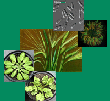| van Veen, H; Mustroph, A; Barding, GA; Vergeer-van Eijk, M; Welschen-Evertman, RA; Pedersen, O; Visser, EJ; Larive, CK; Pierik, R; Bailey-Serres, J; Voesenek, LACJ; Sasidharan, R: Two Rumex Species from Contrasting Hydrological Niches Regulate Flooding Tolerance through Distinct Mechanisms, Plant Cell, 25(11), 4691-4707 (2013), doi:10.1105/tpc.113.119016 | |
| Abstract: Global climate change has increased flooding events, which affect both natural vegetation dynamics and crop productivity. The flooded environment is lethal for most plant species because it restricts gas exchange and induces an energy and carbon crisis. Flooding survival strategies have been studied in Oryza sativa, a cultivated monocot. However, our understanding of plant adaptation to natural flood-prone environments remains scant, even though wild plants represent a valuable resource of tolerance mechanisms that could be used to generate stress-tolerant crops. Here we identify mechanisms that mediate the distinct flooding survival strategies of two related wild dicot species: Rumex palustris and Rumex acetosa. Whole transcriptome sequencing and metabolite profiling reveal flooding-induced metabolic reprogramming specific to R. acetosa. By contrast, R. palustris uses the early flooding signal ethylene to increase survival by regulating shade avoidance and photomorphogenesis genes to outgrow submergence and by priming submerged plants for future low oxygen stress. These results provide molecular resolution of flooding survival strategies of two species occupying distinct hydrological niches. Learning how these contrasting flood adaptive strategies evolved in nature will be instrumental for the development of stress-tolerant crop varieties that deliver enhanced yields in a changing climate. |

